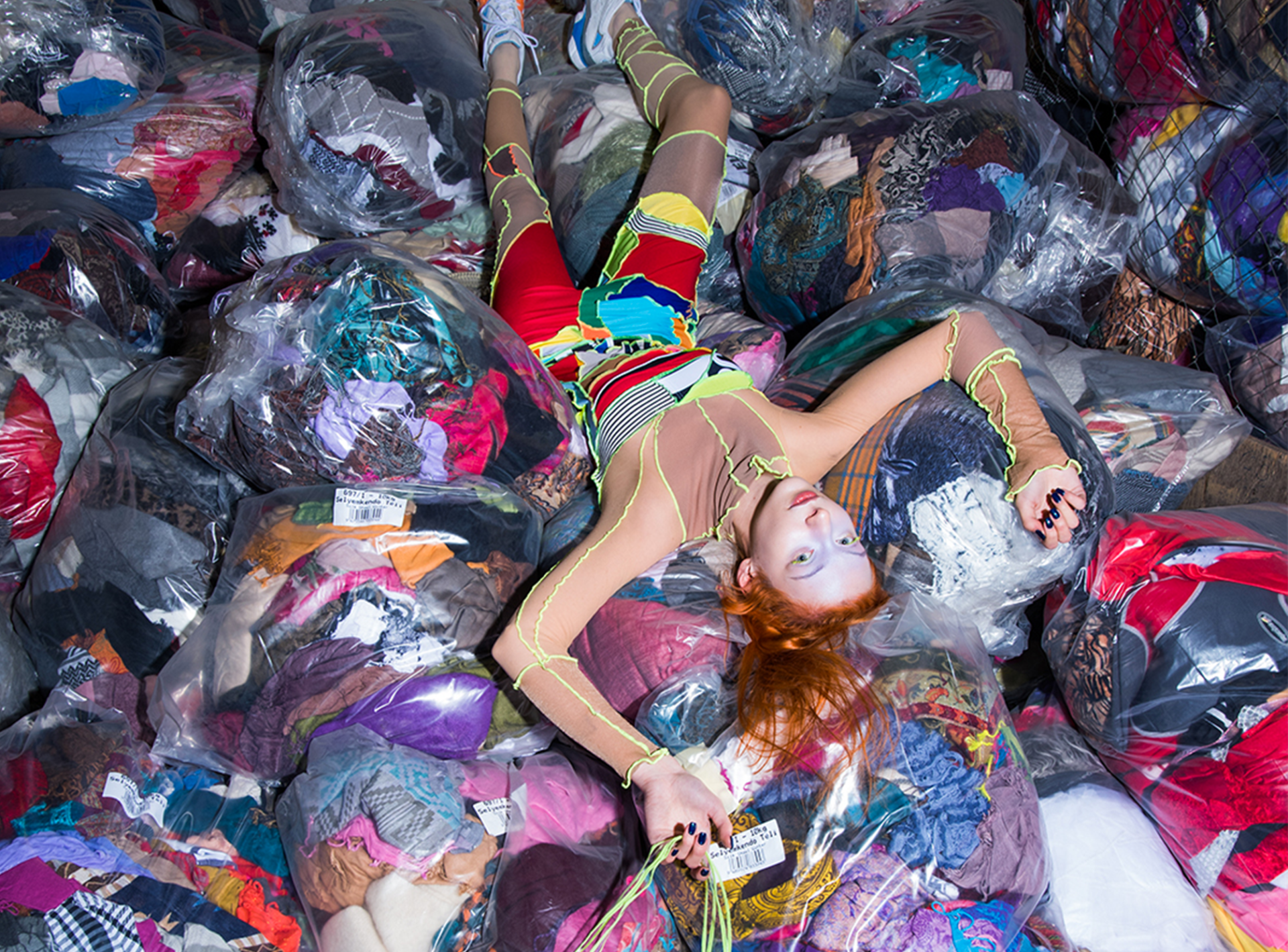How did you become a sustainable fashion designer?
Since I was a kid, I liked to do my own jewelry. First, I made them from cardboard then clay, polymer clay, and resin. I loved to work with plastic, I found this material so versatile and ambiguous, it always fascinated me. Then I started to think if I could somehow reuse household plastic waste. I simply googled it and found some YouTube tutorials. Consequently, I found the Precious Plastic movement so I started experimenting with very simple tools that I had at home and with the kitchen oven. Slowly, I developed my artisanal technique.
Then I started my masters in fashion design and I decided to try more sustainable techniques with textiles too. When I started to upcycle old garments, I realized that this technique is somehow very close to me. It felt like I was doing this my whole life. It is the spirit of what I grew up in: transforming, remaking, and upgrading already existing objects and materials.


You use traditional methods such as patchworking, quilting, and textile collage with vibrant sports- or activewear. Where does your influence come from?
I found lots of cheap and bad-quality sportswear in Romanian and Hungarian second-hand stores. Colourful polyester T-shirts with logos and prints – but many of them lost their meaning when separated from their original context. Football teams that no one knows in Romania, a local basketball club from a small town from who-knows-which country, then some phone numbers to a bicycle shop in Canada. It’s random and chaotic but I think this is the new raw material of the 21st century. I find it very honest when all these garments are stuffed randomly in bags in a little charity shop. In the fancy fast-fashion stores, one can be easily fooled by the carefully arranged shelves. But the second-hand stores show a way more realistic image of our times. So I would like to keep this realness in my garments. I would like them to tell this story of unwanted, irrelevant cheap clothes.

Some designers treat the body like a canvas. When you create a garment, do you have a certain body type on your mind or you are above that?
I have lots of oversized items, many of them are unisex. I also prefer simple and versatile solutions. I work a lot with patchworks, my favorite technique is that I create a new fabric from little pieces. And then this fabric is transformed into a 3D model with a hybrid technique somewhere between pattern making and draping. So, I have some basic patterns but they can be easily adapted to anyone’s body. Since it’s a big chaos of colourful patches, they can be added or removed, almost like Lego bricks.



From SONS OF CEPHISSUS to THE VENUS OF THE RAGS collection, I can see a lot of development and increasing complexity. Can you shortly describe your designing process?
Usually, my design process is very intuitive. What I’m going through in different situations is often reflected in my work. Classic designing processes can help (like moodboards and prototypes) but I don’t always follow these steps. In many cases, I have to reinvent everything since working with post-consumer waste is very different from a classic fashion production system.
You actively spread awareness in schools about the fast fashion industry. How does the younger generation react during the workshop?
Usually, they are very open and very interested in these topics. For example, in the Romanian educational system, there is very little information about environmental issues but young generations have lots of information from the internet. On one hand, they are exposed to the endless advertising from all social media channels but on the other, they can also see the warnings and the devastating consequences of overproduction.
I think it’s very important to raise awareness of the importance of their choices. It’s good to learn from an early age that your purchases are important and always has consequences, either good or bad.



What are your designer goals? Still predominantly with textile waste or do you have your eye on some other technology?
At the moment, I’m thinking about continuing with textile waste. I’m also interested in how to recycle plastic in a more wearable way, I would like to develop materials made from recycled plastic bags or to continue the experiments with melting polyester.



What are you working on right now?
I am working on my new collection. I use this unusual situation generated by COVID-19 to rethink my brand, the production, the timing of the collections, etc. I am also working on some strategies to somehow connect different upcyclers around the world. This could be a whole new way of working together, a new production model, and a relevant alternative to overproduction.

BIO / Borbala is a fashion brand based in Budapest, focusing on upcycling and plastic recycling. They create one of a kind experimental garments and earrings from post-consumer plastic waste, leftovers, and second-hand clothes. They deconstruct second-hand clothes while pushing forward traditional techniques and DIY methods like patchworking or textile collage. Their aesthetic is spontaneous and colourful, always playing around with the concept of old and new, wasted and precious, traditional and contemporary. Collaborations, workshops and sharing knowledge is an essential part of their activity.
CREDITS
Interview / Kateřina Hynková
1-2 / Photo @robin_czunderlik, Model @sabaa_o, Makeup @viragzsofimakeup , Styling assistant @ascheegu , Clothes and styling @b_o_r_b_a_l_a_
3 / Photo @lisamiquet , Model @kocoline styling @selfina_33, top @b_o_r_b_a_l_a_ 4 , Photo @norkadorkaa editing and earrings @b_o_r_b_a_l_a_
5-9 / Photo @gregusmate @marieclairehungary
10 / Photo @szathina Editing/model/clothes @b_o_r_b_a_l_a_
11-13 / Photo/clothes/ styling @b_o_r_b_a_l_a_ , Styling assistant @aquariana_vidente , Model @eszterkilyen




